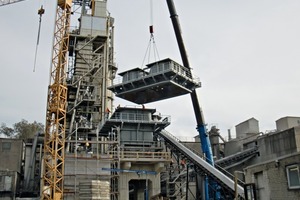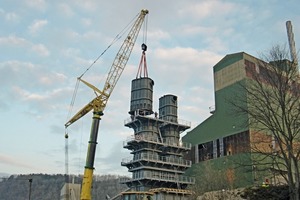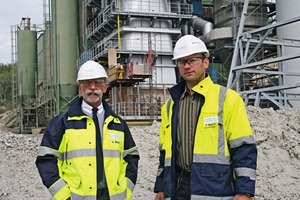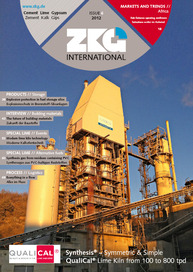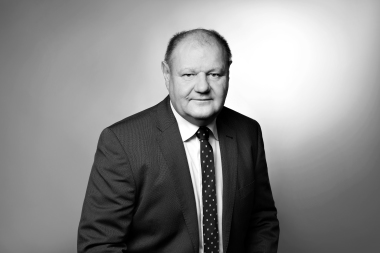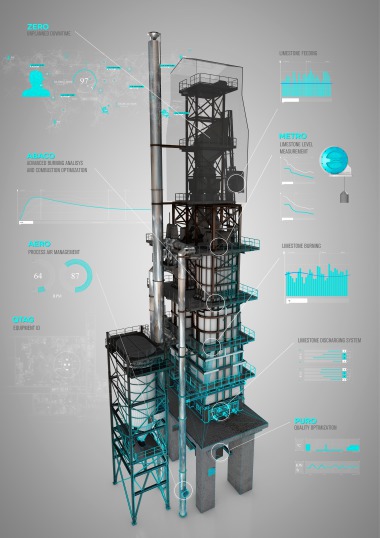Lime in all its diversity is the product and the passion of Calcis, an association of medium-sized companies with three locations in Germany. Calcis manufactures the full range of possible lime products, from burnt lime and hydrated lime products through to unburnt products. Taken together, the association’s factories have a capacity of 500 000 t of burnt products and 100 000 t of unburnt products. In addition, they market 300 000 t of grits and aggregates in cooperation with partner firms. Like most other companies, Calcis is compelled to constantly modernize and optimize its plants. In mid 2011, its Warstein factory commissioned a new parallel-flow regenerative kiln system equipped with a Synthesis 85 kiln supplied by Qualical of Bergamo/Italy. A new kiln is also currently under construction at the Lienen factory and is due to come on stream in July/August 2012 after a construction period of 12 months. ZKG International interviewed Managing Director Detlev Wegner and Plant Manager Per Wasner about the company and its modernization projects.
ZKG: Mr. Wegner, what is the story behind the name Calcis?
Detlev Wegner: Calcis is the collective brand name of the medium-sized companies that belonged to the former Schencking Group. This association of companies has been active under that name since 2011, marketing a full range of products. Assisted by an advertising agency, we looked for an umbrella brand name that would be representative of our various products and would be catchy and memorable. Our adoption of this name has been a great success in that our customers very quickly got used to it. The consolidated companies comprise Calcis Warstein GmbH & Co. KG and Calcis Lienen GmbH & Co. KG, and the affiliated Brochterbeck location. When we changed the company form we also modified our web site and presented it in four languages. Our web site uses memorable and meaningful product family names like CALSICAL (calcium oxide) and OXYCAL (calcium dihydroxide) and has quickly established them as popular synonyms for our products manufactured, for instance, to DIN EN 459-1 and correspondingly designated. This has been so successful that our product names are even used in invitations to tender.
ZKG: What can you tell us about the history of the factories?
Detlev Wegner: At the Lienen works we started in 1952 with open pot furnaces and later with standard shaft kilns of the simplest type. Finally, two reciprocating table kilns were installed. We took over the Warstein works in 1995. Its almost unused multichamber shaft kiln was modified to suit our needs and upgraded. We also optimized its shaft kiln for hard burnt products and put it into operation.
Per Wasner: In 2009 we took account of the ecological and economical situation by ordering a Synthesis 85 kiln from Qualical, which we put into service in July 2011. Today, we are achieving first-class results with this kiln.
Detlev Wegner: This kiln has extended the Calcis product portfolio on the sector of high-grade soft burnt limes with t60 values clearly below 2 minutes and CO2 figures significantly below 2 %. In the Brochterbeck works belonging to Calcis Lienen there are two standard shaft kilns that were put into operation in 2010, each with a capacity of about 40 tpd. Brochterbeck manufactures CL 80 hydrated lime as well as certain carbonate fertilizers and NHL products (natural hydraulic limes). This production plant therefore contributes to a significant enhancement of the Calcis product family.
ZKG: How do you ensure sustainable and future-oriented production?
Per Wasner: We are certified to DIN EN ISO 9001. In the coming months we will also undergo the certification process for energy management.
Detlev Wegner: The management certification opens up the way for a number of certification possibilities, for instance environmental certification. At present, we are implementing an energy management in accordance with ISO 50001. This is our reaction to political and legal requirement profiles, but naturally we are hoping to derive business advantages from this system.
ZKG: Do the plants use different raw materials?
Per Wasner: The Warstein works processes compact Devonian limestone with CaCO3 contents of 95–98 %, while Lienen processes Cenomanian limestone with CaCO3 contents of 85–92 % and corresponding secondary constituents. That is a reason why our Lienen works concentrates on the calcium silicate industry.
Detlev Wegner: In Lienen we use the CaCO3 content and also specifically the minor raw material constituents for production of our special limes. When manufacturing, for instance, sand-lime bricks, these lime products ensure high green brick strength at a lower CaO usage and incorporation of the hydraulic factors. This achieves an optimum combination of sand lime brick characteristics without the risk of free CaO being present after the hydrothermal hardening. Another significant point is that no admixture of products from other manufacturers is necessary.
Calcis always had the aim of offering more and more custom-tailored products, for instance in respect of particle size range, reaction time and solubility, in order to satisfy the requirements of every application. The extensive product development programme in our laboratories and the specifically directed backup with regard to the application technology often result in the creation of special products that can be transported over long delivery routes. Together with our customers we can also react quickly and efficiently to special basic conditions, for instance fuels, which are an important factor in the manufacturing of lime. In cooperation with our customers we have developed products that fully satisfy the quality requirements even after a change of fuel. The essential requirement for quality and technical developments is a market-oriented price development.
ZKG: You planned a modernisation project for the Lienen works. What was your decision matrix?
Per Wasner: At first we favoured a solution with two shaft kilns joined together via a cross-over channel. We thoroughly analyzed this project and in the end decided that we could not put it into effect because the kiln manufacturer would not provide the required quality warrantees and because the financial expense was too great. We therefore decided to install a new kiln. Because of the positive experience gained in Warstein we decided to install an identical QualiCal Synthesis 85 kiln with a capacity of up to 400 tpd. This kiln was modified to permit the use of Cenomanian limestone. Essentially, the kiln is the same design as the QualiCal kiln in Warstein and this duplication brings us advantages for both locations with regard to spare parts inventory, development of identical control systems etc.
ZKG: How was your experience with the new kiln system in Warstein incorporated into the project planning for Lienen?
Per Wasner: In the commissioning phase the modifications concerning the system, location and operation were successfully carried out in close coordination with a team of experts from QualiCal. One example is modified control of the filling level measuring devices as a function of the kiln discharge table operation. Also, the sliding table movement is no longer measured via effectors. Precise movement distance measurement assures uniform motion of the column of material in the shafts. Together with QualiCal, we successfully modified the entire kiln control system. This included replacing the previously separate control of air and fuel quantities with a system using the reference variables of tonnage and air factors as controlled variables. Further functions are automatically adjusted by the control system, for example the fuel distribution is automatically adjusted to suit the output rate. Many more developments are being undertaken in cooperation with QualiCal and will be incorporated into future kiln generations.
Detlev Wegner: Such developments for the industry on the basis of actual industrial experience are extremely important. Thanks substantially to the support provided by Qualical, the project in Warstein was executed quickly and effectively. However, with such projects one can never fully rule out the occurrence of problems at inconvenient times. When necessary, QualiCal provided round-the-clock help.
Per Wasner: If problems arise, the technical crew of the plant, and also the Qualical experts, could and can access the control system via a secure electronic link, obtain an overview of the situation and together – online – perform a fault diagnosis.
Detlev Wegner: The kiln has also been optimized with regard to the raw material. Qualical analyzed the Lienen Cenomanian limestone in the laboratory and in semi-industrial-scale tests and used the results as a basis for the kiln design.
Per Wasner: To our knowledge Lienen is the first plant to burn a Cenomanian lime in a parallel-flow regenerative process. That makes the construction of kiln 7 in Lienen a world first!
ZKG: How do your locations differ with regard to the fuels used?
Per Wasner: In Warstein we use hard coal coke and anthracite for the standard shaft kiln and for the multi-chamber inclined shaft kiln we use butane gas and petcoke dust. That kiln has now been modified and after its recommissioning it will be operated with lignite dust. For the parallel-flow regenerative kiln (kiln 3) we use lignite dust as fuel.
The Lienen location has always used anthracite coal and lumpy petcoke in the standard shaft kilns and petcoke dust and natural gas in the reciprocating table kilns. The reciprocating table kilns are currently being converted to lignite dust. The new parallel-flow regenerative kiln in Lienen can be operated with gas and with lignite dust, as well as with other pulverized fuels.
Lignite dust feeding is handled by dosing systems from Carbotechnik. Our experience regarding dosing precision and the sealing quality of the general handling system has been very positive. To obtain the best production output it is imperative to adjust the fuel metering to the individual kiln burner segments. In the context of the fuel system this is only one aspect of the experience gained and implemented together with QualiCal. Stable quality is a direct function of the fuel distribution and the implemented kiln production rate (200–400 tpd).
Detlev Wegner: Experience has clearly shown that the use of lignite dust with precisely determined quality and characteristics has no negative effect on product quality at all. When selective physical post-processing of the product is carried out, outstanding lime properties can be achieved.
ZKG: Thank you very much for the interview. We wish you continued success in the future.

